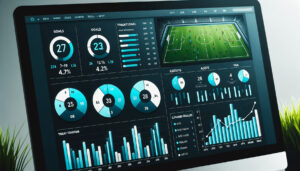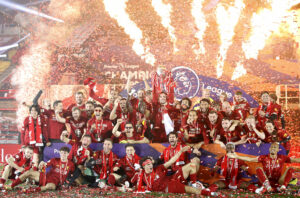06 Oct 23
Data Analytics in football: How LFC Used Data to Gain the Edge
Liverpool Football Club’s ascent to the pinnacle of English football wasn’t just about passion or luck. Behind the loud roars of the Kop and the ceaseless spirit of their fans, they left their mark on data analytics in football- diligently crafting a success story. This article provides a breakdown of how Liverpool Football Club used data and math to up its game and works as a case study to show how data analytics in football can be leveraged.

Ian Graham’s Mathematical Model for Data Analytics in Football
Up against financial titans like Manchester City, Chelsea, and Manchester United, Liverpool’s tactics in the transfer market needed innovation. This is when Dr. Ian Graham and his groundbreaking mathematical model came into the picture.
Dr. Ian Graham’s mathematical models adopted advanced analytics to assess player performance beyond what traditional stats showed. This unique perspective didn’t just focus on a player’s goal or assist tally but illuminated the potential impact they could make within Jürgen Klopp’s tactical framework. Now what did these mathematical models include and why were they so pivotal in the context of data analytics in football?

-
- Expected Goals (xG) and Assists (xA): A refined way of assessing a player’s potency in front of the goal, moving beyond just the number of goals or assists they produced. Graham’s model also calculated the probability of scoring or assisting after any given action a player makes; a pass, interception, recovery, etc. This was pivotal in determining how effective certain players would be within the tactical system.
- Defensive Contributions and Pressing Metrics: Essential for a system like Jürgen Klopp’s ‘gegenpressing,’ these metrics, derived from sophisticated data analytics in football, evaluated a player’s off-the-ball work rate and defensive prowess. Players such as Firminio benefitted from these insights, the attacking midfielder adopted a new role under Klopps management and revolutionised the false 9 position.
- Positional and Game State Data: Beyond just what a player does with the ball, understanding their movements and performance under varying game circumstances became crucial. Identifying where the players wanted to be to maintain the high press as well as protecting the back line from potential counters.
- Injury History and Physical Metrics: Utilising a player’s injury history, stamina, top speed, and other physical data was vital for Klopp’s high-intensity ‘gengenpressing’ system. Without the squad depth of rivals Manchester City, Liverpool were able to compete across all competitions, with the main starting 11 playing over 80% of the total minutes in the premier league season.
Monitoring the Physical Data Analytics in Football

Liverpool has strategically harnessed the power of data analytics in football to elevate their game and ensure superior player management. By deploying tracking systems and aerial cameras, the club captures real-time positioning data of both players and the ball during matches. This initiative facilitates thorough match analysis and recruitment work, showcasing the practical application of data analytics in football.
The partnership with SkillCorner further amplifies Liverpool’s data analytic capabilities, leveraging live video analytics to monitor ball and player movements, a crucial aspect in evaluating performance and detecting player fatigue. The integration of wearable technology, particularly a fitness tracking system, during training sessions underscores another dimension of data analytics in football at Liverpool. It provides critical metrics such as distance covered, speed, and physical impacts, which are instrumental in monitoring player fatigue and overall physical performance.
At the heart of these technological endeavors is a dedicated data analysis team led by Ian Graham, the director of research. The team’s role spans pre and post-match analysis, sports science explorations, and recruitment endeavors, embodying the essence of data analytics in football. Under Sporting Director Michael Edwards, Liverpool has championed innovative data science approaches, particularly focusing on granular analysis of pitch control, seamlessly weaving data analytics in football into top-level decision-making processes. This focus not only drives strategic planning but also engenders a deeper understanding of player performance on the field.
The club’s exploration into predictive and evaluative analytics, facilitated by wearables, exemplifies the broader scope of data analytics in football. It enables a data-driven culture that continuously strives for performance improvement, thus crafting a competitive edge for Liverpool FC in the football arena. Through these multi-faceted approaches, data analytics in football is no longer a mere concept but a practical tool that propels Liverpool towards sustained success on the football field.
Player Recruitment and the ‘Moneyball’ Philosophy
By combining Liverpool’s ‘Moneyball’ philosophy with Graham’s algorithmic insights into the data analytics in football led to some of the Premier League’s most shrewd acquisitions.
- Mohamed Salah: Salah’s acquisition from AS Roma in 2017 for a sum of £36.9 million raised many an eyebrow. However, Graham’s model highlighted Salah’s exceptional off-the-ball movements and his expected goals (xG), suggesting the fee was a savvy investment. Salah went on to break the Premier League goalscoring record in his debut season and has gone on to be the Premier League’s top goal scorer three times matching legendary strikers Alan Shearer and Harry Kane.
- Sadio Mané: Bought from Southampton for about £34 million in 2016, Graham’s metrics accentuated Mané’s ability to carve out goal-scoring opportunities and disrupt defensive alignments – an invaluable trait for Klopp’s system.
- Roberto Firmino: The £29 million investment in Firmino from Hoffenheim in 2015 turned out to be a masterstroke. Firmino wasn’t a conventional striker, but his pressing metrics and link-up play, spotlighted by the model, made him essential to Liverpool’s frontline.
The front three went on to cause havoc in both the Premier League and Champions League. Costing a total of less than £100 million they went on to become one of the deadliest trio in the world and arguably the best front three ever. Proving that with the effective utilisation of data analytics in football, Liverpool were able to identify not only players that would succeed individually, but would build a relationship that would frighten the defensive for years to come.
The Coutinho Windfall
The model’s prowess wasn’t only in acquisition but also in strategic sales. Coutinho’s staggering £142 million transfer to Barcelona in 2018, from an initial outlay of £8.5 million, demonstrated the efficiency of knowing when to capitalise on a player’s peak market value. The profit accumulated from this sale led to the key signings of Virgil Van Dijk and Allison Becker, players who played a huge role in the club’s success.

Despite not wielding the financial clout of some of their competitors, Liverpool’s astute, data-informed recruitment strategy allowed them to outperform clubs with deeper pockets. A blend of value-centric signings, lucrative sales, and Graham’s mathematics in this blical acumen was the secret sauce in their title-winning formula. Liverpool’s Premier League victory narrative is as much about footballing flair as it is about it being revolutionary for data analytics in football. Merging traditional scouting insights with Dr. Ian Graham’s mathematical expertise, Liverpool painted a tale of triumph that underscores the power of data analytics in football.
Interested in joining our diverse team? Find out more about the Rockborne graduate programme here.
Frequently asked questions on the topic of Data Analytics in Football!
Do Football clubs hire data analysts?
Yes, football clubs do hire data analysts. The use of data analysis in football has grown significantly over the years, with clubs employing data analysts to optimize various facets of their operations and performance. In Player Performance Analysis, analysts evaluate metrics like distance covered, speed, and passing accuracy to aid coaching decisions. They also track player performance across matches or seasons for trend identification and tactical planning. In Opponent Analysis, the focus shifts to studying rivals’ strategies and player performances to prepare for upcoming matches, using historical data for predicting opponent tactics. Recruitment leverages data analysis to scout players fitting the club’s criteria, enabling informed recruitment decisions. Injury Prevention and Rehabilitation involve identifying injury risks and monitoring rehabilitation through data analytics, ensuring timely return to play. For Fan Engagement and Marketing, analysts harness fan data to refine marketing strategies and enhance fan experiences, including targeted marketing campaigns. Lastly, in Financial Analysis, they manage and scrutinize financial data for budgeting, forecasting, and informed financial decision-making, contributing to the club’s financial stability and sustainability.
What is the role of a Data Analyst in Football?
The majority of professional football clubs employ in-house analysts tasked with examining the opposition, reviewing their own team’s performances, pinpointing strengths and weaknesses, and devising strategies accordingly.
How much does a football analyst make UK?
As of 2023, the depicted employee earns £30,833 annually; more specifically, the pay rate stands at £2,569 monthly, £593 weekly, or £15.23 hourly.
Where can I get football data for analysis?
While searching for data for your upcoming analysis, ensure to explore the resources provided by FIFA, FB Ref, and Statsbomb. If these sources don’t meet your needs, you might want to utilize Python for data scraping and preparation.
What apps do football analysts use?
Football analysts utilize a variety of apps to gather insights, analyse player performance, and keep up with football events. From the information provided, here are some of the top-rated football analysis apps along with their ratings:
The Athletic:
Known for in-depth analysis and coverage of football among other sports.
Provides articles from reputable journalists and analysts.
SofaScore:
Provides live scores, player statistics, and other real-time match data.
Allows analysts to follow team performances and compare players.
OneFootball:
Offers live updates, scores, and football news.
Features player and team statistics for performance analysis.
FotMob:
Provides live scores, match statistics, and player ratings.
Offers detailed match analysis, making it a handy tool for football analysts.
How do you get a job in football analysis?
Securing a job in football analytics necessitates a solid understanding of the field. Pursuing a university degree in the subject is one avenue to consider. Numerous courses are available, providing an extensive education in the domain, although they require a minimum of three years to complete and entail substantial tuition costs.
Do football clubs have Data Scientists?
Professional football clubs both in the Premier League and EFL nationally, as well as internationally, employ Data Scientists.
Related posts
Life at Rockborne20 Jun 25
Federated Learning: The Future of Collaborative AI in Action
Federated Learning: The Future of Collaborative AI in Action The way we build, deploy, and govern AI is evolving, and so are the expectations placed on organisations to do this...
09 Sep 24
Tips to Succeed in Data Without a STEM Degree
By Farah Hussain I graduated in Politics with French, ventured into retail management, dabbled in entrepreneurship, a mini course in SQL and now… I am a Data Consultant at Rockborne....
15 Apr 24
Game Development at Rockborne: How is Python Used?
Just how is Python used in game development? In this blog post, we see the Rockborne consultants put their theory into practice. As the final project in their Python Basics...

